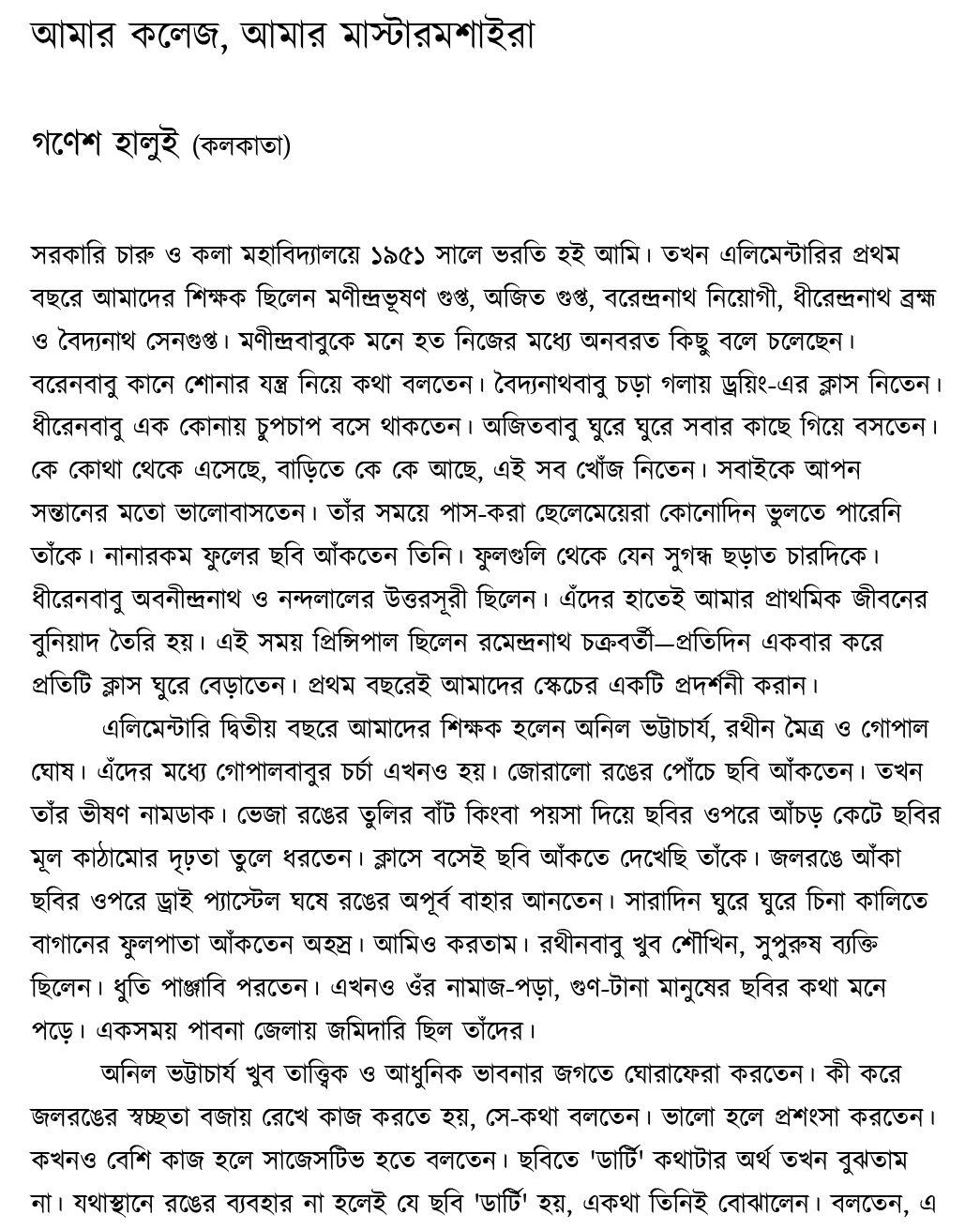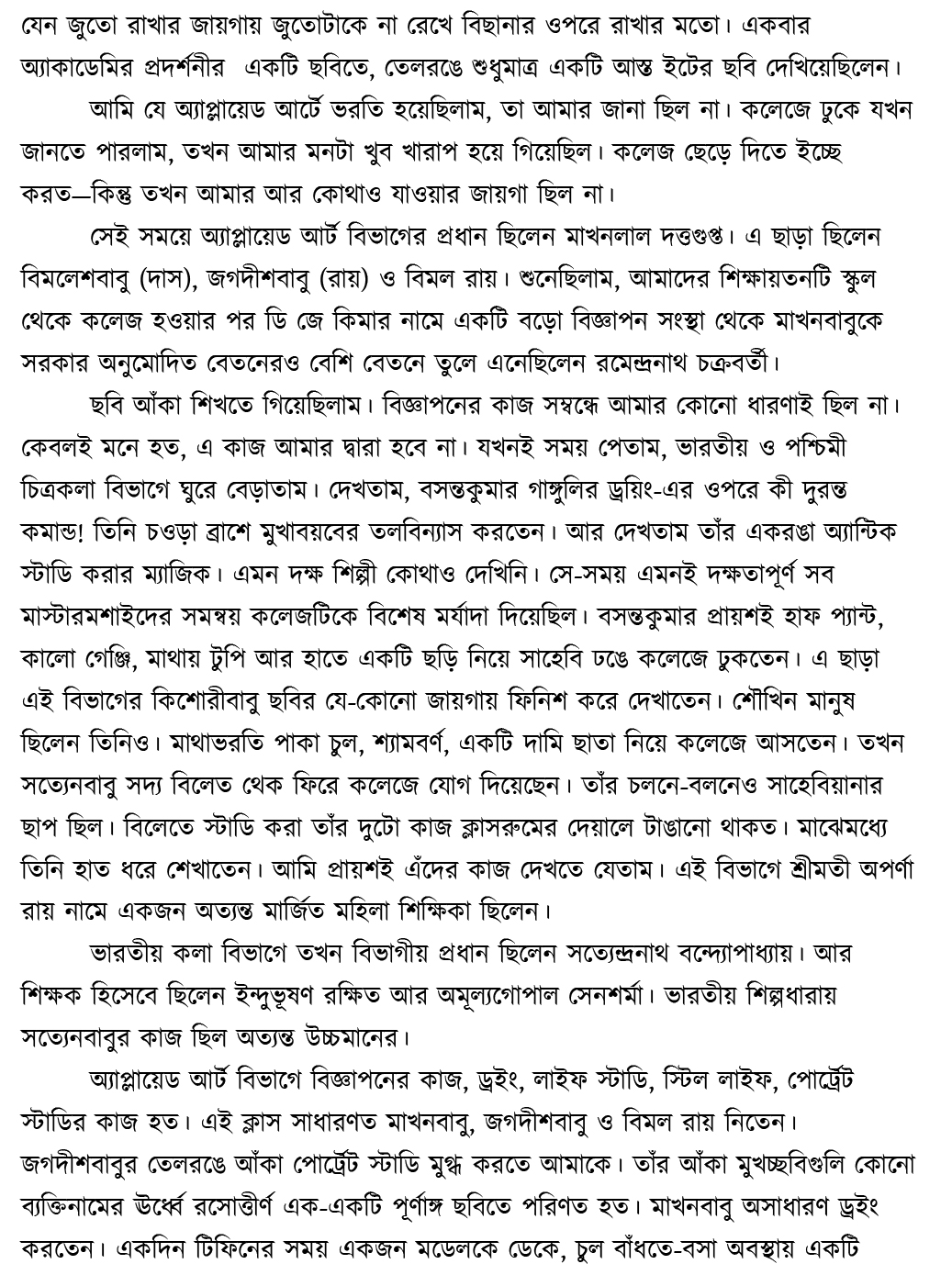



My College, My Teachers
Ganesh Haloi (Kolkata)
In 1951, I took admission in Government College of Art and Craft, in Kolkata. In the elementary first year we had the following eminent teachers: Manindra Bhushan Gupta who apparently seemed to be speaking to himself always, Barendranath Neogi who used hearing machines, Baidyanath Sengupta who took our ‘Drawing’ Class in extremely loud voice, Dhirendranath Brahma who sat quietly at a corner of the class and Ajit Gupta who roamed inside the class, from one student to other, asking their whereabouts in details. Ajit Babu adored and cared for his students like they were his own children. His students could never forget him. He used to paint different kinds of flowers and they looked so real that we could feel as if the air is filled with their fragrances. Dhiren Babu was a successor to Nandalal Basu who was that to Abanindranath Tagore. The above mentioned faculties are the ones who created my strong foundation of my journey with art. In those days our Principal was Ramendranath Chakraborty, who daily visited each class once. He arranged for a sketch exhibition in our first year itself.
In our elementary second year we had three teachers- Anil Bhattacharya, Rathin Maitra and Gopal Ghosh. Gopal Babu is still popular and discussed. I remember his technique of using strong colours and bold strokes for which he was famous then. He used the hard tip of the brush and/or coins to scratch on wet watercolours to strengthen the subject of the painting. I have seen him sit and paint in the class itself. His unique way of mixing dry pastel with watercolours created amazing colour effects and patterns. He used to roam about in the gardens and paint numerous flowers and leaves using chinese ink. I also did the same. Rathin Babu was a classy handsome man, always clad in ethnic dhoti and Punjabi. He belonged to the Zamindar family of Pabna. I still haven’t been able to forget some of his paintings like that of a man sitting for namaz (Islamic prayer).
Anil Babu was a man of the modern world, informative and systematic. He used to teach us how to be neat with watercolors. He praised us when we painted well. If the work was overwhelming, he asked us to be suggestive. I didn’t know what is ‘dirty’ in a painting then. He told us that ‘dirty’ means not being able to use appropriate colours. He used a funny simile about inappropriate colous, i.e., it is like one placing his shoe on the bed instead of the shoe rack. Once he showed us an oil painting of only a brick on canvas.
I didn’t know that I had been placed in ‘Applied Art’ department unless I joined college. I wanted to quit but had nowhere else to go then.
Makhonlal Duttagupta was the Head of the Department of ‘Applied Art’. He was specially invited from a popular advertisement agency to teach by the Principal, with a hefty salary, even higher than that sanctioned by the government. The department also had other teachers- Bimalesh Das, Jagadish Roy and Bimal Roy.
I went to college to learn painting. I had no idea of how to work for advertisements and I often felt that I would not be able to. In my free time, I rushed to ‘Indian and Western Art’ department. Basanta Kumar Ganguly’s command over his drawings inspired me and the magic of his single colour antique study mesmerized me. I had never seen anyone else with such expertise. In those days such expert and renowned faculties enhanced the prestige of our college. Basanta Kumar was often seen in college dressed in English style- half pant, black t-shirt and hat with a stick in hand. Kishori Babu of this department also deserves a mention here. He taught us the technique of finishing a painting from any point. He was a man of sophisticated tastes. Head full of grey hair, brownish skinned and an expensive umbrella; that’s how we remember him. It was in those days when Satyen Babu had just returned from abroad and joined our college as faculty. His attitude reflected that of the west. Two of his studies which he did abroad, were put up on a wall of our class room. He used to repeatedly provide hands on training. I visited this department often. They also had an extremely elegant female teacher, Aparna Roy.
Satyendranath Bandyopadhyay was the Head of the ‘Indian Art’ Department. He was well known for his Indian style of painting. The other two faculties of the department were Indubhashan Rakshit and Amulyagopal Sensharma.
Applied Art started intriguing me. Classes were being taken by Makhan Babu, Jagadish Babu and Bimal Roy. We learnt advertisement art, drawing, life study, still life and portrait study. I wondered at Jagadish Babu’s oil portraits. The faces he painted were beyond who the person was and was wholesome. It was as if he poured in the elixir of life in them. I admired Makhon Babu’s drawings. Once during lunch break he called a model and sketched her tying her hair with charcoal. It was an enormous sketch. He then called me first to see it. The rest saw after that and were speechless. I remember this work being awarded the first position in that year’s Annual Exhibition at Academy of Fine Arts. It was also on the back cover of the catalogue.
We had our share of fun too. The students of the ‘Indian Art’ department called those of the ‘Western Art’ ‘’Mlechho’’, and the students of ‘Western Art’ called them ‘’Labango lotika.’’
Whenever I found free time, I went and sat in the ‘Indian Art’. Most part of the room was covered by low wooden planks with carpets on them. The students sat with legs folded and painted on extremely low desks. This room was connected to the picture gallery of the museum. Many a times we walked through this room to visit the picture gallery. The gallery helped us make copies during ‘Miniature’ classes. Here we learnt about making mixtures, adhesive for strengthening colours using tamarind seeds and how to use Nepali paper.
Abanindranath Thakur left us in 1951. Before his cremation, he was brought to the campus. We, the students and the teachers, attended the funeral at Keoratala Crematorium.
As far as I can recollect, in 1953, Ramen Babu expired unexpectedly because of brain hemorrhage. We could clearly feel the absence of such a good and pure soul. In those days, Sunil Sen was the Vice-Principal. He was an absolute calm and well behaved man clad in ethnic dhoti Punjabi. His expertise was compared to Dutch artists. His wash paintings were ultimate. Many might have forgotten him. He expired just after a few days of his retirement. His art works were lying down unarranged and unattended, which later were purchased by Delhi Art Gallery’s Ashish Anand.
Today none of my teachers are alive. My heartfelt gratitude and respect for them, on teachers’ day. I am proud to have been a student of Government College of Art and Craft, Kolkata.
Thankfully, our college is not a factory producing garbage.
(English Version by Dipannita Bhattacherya)

